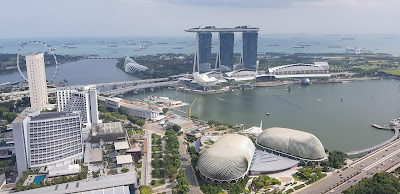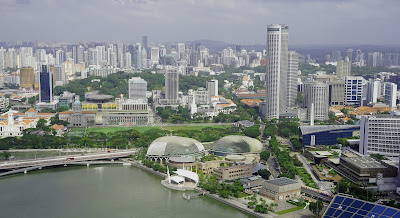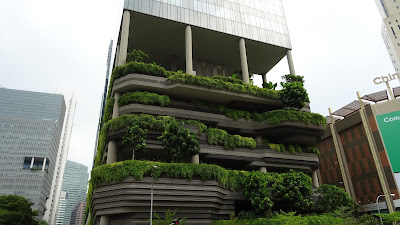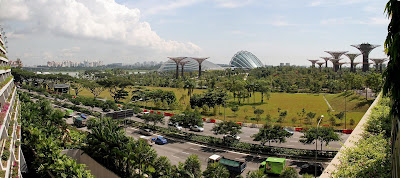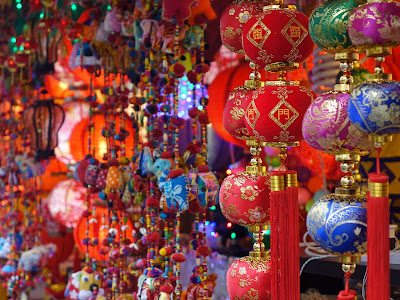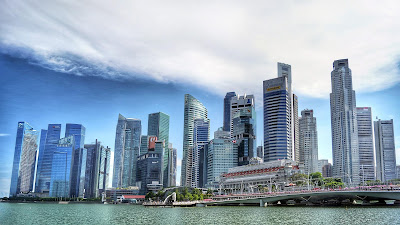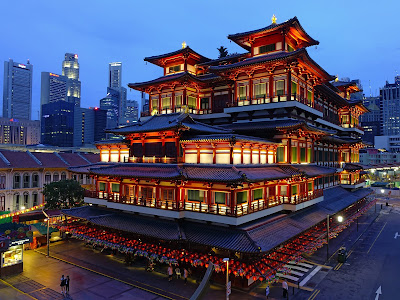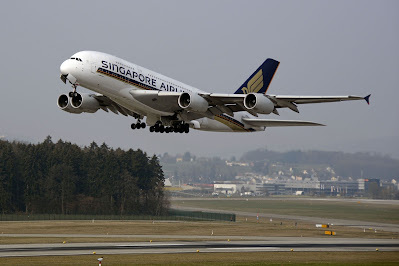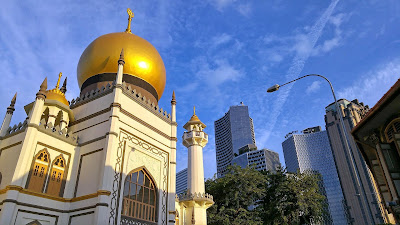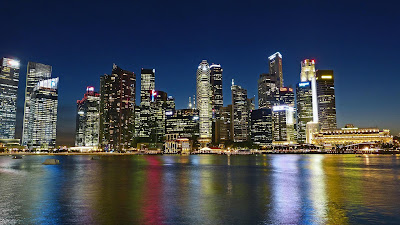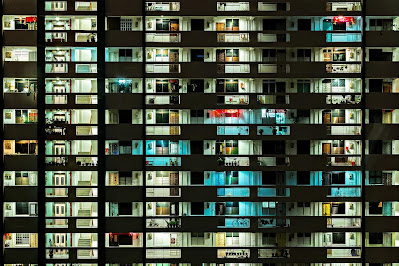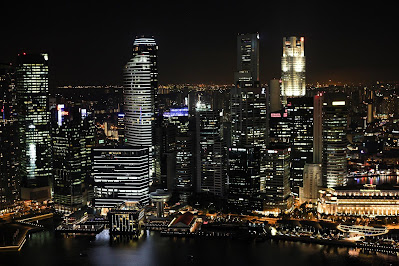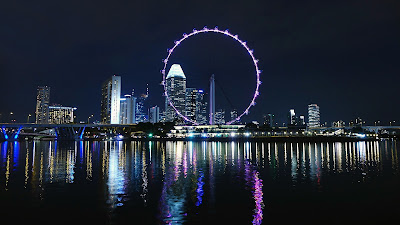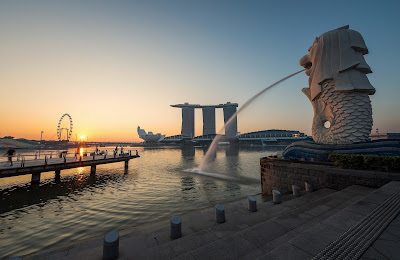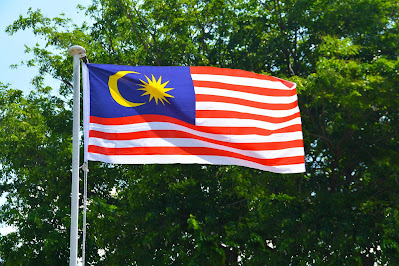All About Singapore / Singapore Tourism
Singapore's history dates back at least a millennia, having been a maritime emporium known as Temasek and subsequently as a major constituent part of several successive thalassocratic empires. Its contemporary era began in 1819 when Stamford Raffles established Singapore as an entrepôt trading post of the British Empire. In 1867, the colonies in Southeast Asia were reorganised and Singapore came under the direct control of Britain as part of the Straits Settlements. During the Second World War, Singapore was occupied by Japan in 1942, and returned to British control as a separate crown colony following Japan's surrender in 1945. Singapore gained self-governance in 1959 and in 1963 became part of the new federation of Malaysia, alongside Malaya, North Borneo, and Sarawak. Ideological differences, most notably the perceived encroachment of the egalitarian "Malaysian Malaysia" political ideology led by Lee Kuan Yew into the other constituent entities of Malaysia – at the perceived expense of the bumiputera and the policies of Ketuanan Melayu – eventually led to Singapore's expulsion from the federation two years later; Singapore became an independent sovereign country in 1965.
Singapore is a unitary parliamentary republic with a Westminster system of unicameral parliamentary government, and its legal system is based on common law. While elections are free, the government under the People's Action Party wields significant control over politics and society, with limits on assembly, association, expression and the press except for the Speakers' Corner; the party having ruled continuously since full internal self-government was achieved in 1959, with 83 out of 104 seats in Parliament as of the 2020 election, the rest of the elected seats being held by the Workers' Party. One of the five founding members of ASEAN, Singapore is also the headquarters of the Asia-Pacific Economic Cooperation (APEC) Secretariat, the Pacific Economic Cooperation Council (PECC) Secretariat, and many international conferences and events. Singapore is also a member of the United Nations, World Trade Organization, East Asia Summit, Non-Aligned Movement, and the Commonwealth of Nations.
In 1299, according to the Malay Annals, the Kingdom of Singapura was founded on the island by Sang Nila Utama. Although the historicity of the accounts as given in the Malay Annals is the subject of academic debates, it is nevertheless known from various documents that Singapore in the 14th century, then known as Temasek, was a trading port under the influence of both the Majapahit Empire and the Siamese kingdoms, and was a part of the Indosphere. These Indianised kingdoms were characterised by surprising resilience, political integrity and administrative stability. Historical sources also indicate that around the end of the 14th century, its ruler Parameswara was attacked by either the Majapahit or the Siamese, forcing him to move to Malacca where he founded the Sultanate of Malacca. Archaeological evidence suggests that the main settlement on Fort Canning was abandoned around this time, although a small trading settlement continued in Singapore for some time afterwards. In 1613, Portuguese raiders burned down the settlement, and the island faded into obscurity for the next two centuries. By then, Singapore was nominally part of the Johor Sultanate. The wider maritime region and much trade was under Dutch control for the following period after the Dutch conquest of Malacca.
Within Malaysia
PAP leaders believed that Singapore's future lay with Malaya, due to strong ties between the two. It was thought that reuniting with Malaya would benefit the economy by creating a common market, alleviating ongoing unemployment woes in Singapore. However, a sizeable pro-communist wing of the PAP was strongly opposed to the merger, fearing a loss of influence, and hence formed the Barisan Sosialis, splitting from the PAP. The ruling party of Malaya, United Malays National Organisation (UMNO), was staunchly anti-communist, and it was suspected UMNO would support the non-communist factions of PAP. UMNO, initially sceptical of the idea of a merger due to distrust of the PAP government and concern that the large ethnic Chinese population in Singapore would alter the racial balance in Malaya on which their political power base depended, became supportive of the idea of the merger due to joint fear of a communist takeover.
On 27 May 1961, Malaya's prime minister, Tunku Abdul Rahman, made a surprise proposal for a new Federation called Malaysia, which would unite the current and former British possessions in the region: the Federation of Malaya, Singapore, Brunei, North Borneo, and Sarawak. UMNO leaders believed that the additional Malay population in the Bornean territories would balance Singapore's Chinese population. The British government, for its part, believed that the merger would prevent Singapore from becoming a haven for communism. To obtain a mandate for a merger, the PAP held a referendum on the merger. This referendum included a choice of different terms for a merger with Malaysia and had no option for avoiding merger altogether. On 16 September 1963, Singapore joined with Malaya, the North Borneo, and Sarawak to form the new Federation of Malaysia under the terms of the Malaysia Agreement. Under this Agreement, Singapore had a relatively high level of autonomy compared to the other states of Malaysia.
Indonesia opposed the formation of Malaysia due to its own claims over Borneo and launched Konfrontasi (Confrontation in Indonesian) in response to the formation of Malaysia. On 10 March 1965, a bomb planted by Indonesian saboteurs on a mezzanine floor of MacDonald House exploded, killing three people and injuring 33 others. It was the deadliest of at least 42 bomb incidents which occurred during the confrontation. Two members of the Indonesian Marine Corps, Osman bin Haji Mohamed Ali and Harun bin Said, were eventually convicted and executed for the crime.[85] The explosion caused US$250,000 (equivalent to US$2,149,683 in 2021) in damages to MacDonald House.
Even after the merger, the Singaporean government and the Malaysian central government disagreed on many political and economic issues. Despite an agreement to establish a common market, Singapore continued to face restrictions when trading with the rest of Malaysia. In retaliation, Singapore did not extend to Sabah and Sarawak the full extent of the loans agreed to for economic development of the two eastern states. Talks soon broke down, and abusive speeches and writing became rife on both sides. This led to communal strife in Singapore, culminating in the 1964 race riots. On 7 August 1965, Malaysian prime minister Tunku Abdul Rahman, seeing no alternative to avoid further bloodshed, advised the Parliament of Malaysia that it should vote to expel Singapore from Malaysia. On 9 August 1965, the Malaysian Parliament voted 126 to 0 to move a bill to amend the constitution, expelling Singapore from Malaysia, which left Singapore as a newly independent country.
Republic of Singapore
After being expelled from Malaysia, Singapore became independent as the Republic of Singapore on 9 August 1965, with Lee Kuan Yew and Yusof bin Ishak as the first prime minister and president respectively. In 1967, the country co-founded the Association of Southeast Asian Nations (ASEAN). Race riots broke out once more in 1969. Lee Kuan Yew's emphasis on rapid economic growth, support for business entrepreneurship, and limitations on internal democracy shaped Singapore's policies for the next half-century. Economic growth continued throughout the 1980s, with the unemployment rate falling to 3% and real GDP growth averaging at about 8% up until 1999. During the 1980s, Singapore began to shift towards high-tech industries, such as the wafer fabrication sector, in order to remain competitive as neighbouring countries began manufacturing with cheaper labour. Singapore Changi Airport was opened in 1981 and Singapore Airlines was formed. The Port of Singapore became one of the world's busiest ports and the service and tourism industries also grew immensely during this period.
The PAP, which has remained in power since independence, is believed to rule in an authoritarian manner by some activists and opposition politicians who see the strict regulation of political and media activities by the government as an infringement on political rights. In response, Singapore has seen several significant political changes, such as the introduction of the Non-Constituency members of parliament in 1984 to allow up to three losing candidates from opposition parties to be appointed as MPs. Group Representation Constituencies (GRCs) were introduced in 1988 to create multi-seat electoral divisions, intended to ensure minority representation in parliament.[105] Nominated members of parliament were introduced in 1990 to allow non-elected non-partisan MPs. The Constitution was amended in 1991 to provide for an Elected President who has veto power in the use of national reserves and appointments to public office.
In 1990, Goh Chok Tong succeeded Lee and became Singapore's second prime minister. During Goh's tenure, the country went through the 1997 Asian financial crisis and the 2003 SARS outbreak. In 2004, Lee Hsien Loong, the eldest son of Lee Kuan Yew, became the country's third prime minister. Lee Hsien Loong's tenure included the 2008 global financial crisis, the resolution of a dispute over land ownership at Tanjong Pagar railway station between Singapore and Malaysia, and the introduction of the 2 integrated resorts (IRs), located at the Marina Bay Sands and Resorts World Sentosa. The People's Action Party (PAP) suffered its worst ever electoral results in 2011, winning just 60% of votes, amidst debate over issues including the influx of foreign workers and the high cost of living. On 23 March 2015, Lee Kuan Yew died, and a one-week period of public mourning was observed nationwide. Subsequently, the PAP regained its dominance in Parliament through the September general election, receiving 69.9% of the popular vote, although this remained lower than the 2001 tally of 75.3% and the 1968 tally of 86.7%. The 2020 election saw the PAP drop to 61% of the vote, while the opposition Workers' Party took 10 of the 93 seats, the highest number ever won by an opposition party.
Geography
Singapore consists of 63 islands, including the main island, Pulau Ujong. There are two-man-made connections to Johor, Malaysia: the Johor–Singapore Causeway in the north and the Tuas Second Link in the west. Jurong Island, Pulau Tekong, Pulau Ubin and Sentosa are the largest of Singapore's smaller islands. The highest natural point is Bukit Timah Hill at 163.63 m (537 ft). Under British rule, Christmas Island and the Cocos Islands were part of Singapore, and both were transferred to Australia in 1957. Pedra Branca is the nation's easternmost point.
Land reclamation projects have increased Singapore's land area from 580 km2 (220 sq mi) in the 1960s to 710 km2 (270 sq mi) by 2015, an increase of some 22% (130 km2). The country is projected to reclaim another 56 km2 (20 sq mi). Some projects involve merging smaller islands through land reclamation to form larger, more functional and habitable islands, as has been done with Jurong Island. The type of sand used in reclamation is found in rivers and beaches, rather than deserts, and is in great demand worldwide. In 2010 Singapore imported almost 15 million tons of sand for its projects, the demand being such that Indonesia, Malaysia, and Vietnam have all restricted or barred the export of sand to Singapore in recent years. As a result, in 2016 Singapore switched to using polders for reclamation, in which an area is enclosed and then pumped dry.
Nature
Singapore's urbanisation means that it has lost 95% of its historical forests, and now over half of the naturally occurring fauna and flora in Singapore is present in nature reserves, such as the Bukit Timah Nature Reserve and the Sungei Buloh Wetland Reserve, which comprise only 0.25% of Singapore's land area. In 1967, to combat this decline in natural space, the government introduced the vision of making Singapore a "garden city", aiming to improve quality of life. Since then, nearly 10% of Singapore's land has been set aside for parks and nature reserves. The government has created plans to preserve the country's remaining wildlife. Singapore's well known gardens include the Singapore Botanic Gardens, a 161-year-old tropical garden and Singapore's first UNESCO World Heritage Site.
Climate
Singapore has a tropical rainforest climate (Köppen: Af) with no distinctive seasons, uniform temperature and pressure, high humidity, and abundant rainfall. Temperatures usually range from 23 to 32 °C (73 to 90 °F). While temperature does not vary greatly throughout the year, there is a wetter monsoon season from November to February.
From July to October, there is often haze caused by bush fires in neighbouring Indonesia, usually from the island of Sumatra. Singapore follows the GMT+8 time zone, one hour ahead of the typical zone for its geographical location. This causes the sun to rise and set particularly late during February, where the sun rises at 7:15 am and sets around 7:20 pm. During July, the sun sets at around 7:15 pm. The earliest the sun rises and sets is in late October and early November when the sun rises at 6:46 am and sets at 6:50 pm.
Singapore recognises that climate change and rising sea levels in the decades ahead will have major implications for its low-lying coastline. It estimates that the nation will need to spend $100 billion over the course of the next century to address the issue. In its 2020 budget, the government set aside an initial $5 billion towards a Coastline and Flood Protection Fund. Singapore is the first country in Southeast Asia to levy a carbon tax on its largest carbon-emitting corporations producing more than 25,000 tons of carbon dioxide per year, at $5 per ton.
To reduce the country's dependence on fossil fuels, it has ramped up deployment of solar panels on rooftops and vertical surfaces of buildings, and other initiatives like building one of the world's largest floating solar farms at Tengeh Reservoir in Tuas.
Economy
Singapore has a highly developed market economy, based historically on extended entrepôt trade. Along with Hong Kong, South Korea, and Taiwan, Singapore is one of the Four Asian Tigers, and has surpassed its peers in terms of Gross Domestic Product (GDP) per capita. Between 1965 and 1995, growth rates averaged around 6 per cent per annum, transforming the living standards of the population.
The Singaporean economy is regarded as free, innovative, dynamic and business-friendly. For several years, Singapore has been one of the few countries with an AAA credit rating from the big three, and the only Asian country to achieve this rating. Singapore attracts a large amount of foreign investment as a result of its location, skilled workforce, low tax rates, advanced infrastructure and zero-tolerance against corruption. It is the world's most competitive economy, according to the World Economic Forum's ranking of 141 countries, with the 2nd highest GDP per capita. Roughly 44 percent of the Singaporean workforce is made up of non-Singaporeans. Despite market freedom, Singapore's government operations have a significant stake in the economy, contributing 22% of the GDP. The city is a popular location for conferences and events.
The currency of Singapore is the Singapore dollar (SGD or S$), issued by the Monetary Authority of Singapore (MAS). It is interchangeable with the Brunei dollar at par value since 1967. MAS manages its monetary policy by allowing the Singapore dollar exchange rate to rise or fall within an undisclosed trading band. This is different from most central banks, which use interest rates to manage policy. Singapore has the world's eleventh largest foreign reserves, and one of the highest net international investment position per capita.
Singapore has been identified as a tax haven for the wealthy due to its low tax rates on personal income and tax exemptions on foreign-based income and capital gains. Individuals such as Australian millionaire retailer Brett Blundy and multi-billionaire Facebook co-founder Eduardo Saverin are two examples of wealthy individuals who have settled in Singapore. In 2009, Singapore was removed from the Organisation for Economic Co-operation and Development (OECD) "liste grise" of tax havens, and ranked fourth on the Tax Justice Network's 2015 Financial Secrecy Index of the world's off-shore financial service providers, banking one-eighth of the world's offshore capital, while "providing numerous tax avoidance and evasion opportunities". In August 2016, The Straits Times reported that Indonesia had decided to create tax havens on two islands near Singapore to bring Indonesian capital back into the tax base. In October 2016, the Monetary Authority of Singapore admonished and fined UBS and DBS and withdrew Falcon Private Bank's banking licence for their alleged role in the Malaysian Sovereign Fund scandal.
Singapore has the world's highest percentage of millionaires, with one out of every six households having at least one million US dollars in disposable wealth. This excludes property, businesses, and luxury goods, which if included would increase the number of millionaires, especially as property in Singapore is among the world's most expensive. In 2016, Singapore was rated the world's most expensive city for the third consecutive year by the Economist Intelligence Unit, and this remained true in 2018. The government provides numerous assistance programmes to the homeless and needy through the Ministry of Social and Family Development, so acute poverty is rare. Some of the programmes include providing between S$400 and S$1000 of financial assistance per month to needy households, providing free medical care at government hospitals, and paying for children's tuition. Other benefits include compensation for gym fees to encourage citizens to exercise, up to S$166,000 as a baby bonus for each citizen, heavily subsidised healthcare, financial aid for the disabled, the provision of reduced-cost laptops for poor students, rebates for costs such as public transport and utility bills, and more. As of 2018 Singapore's ranking in the Human Development Index is 9th in the world, with an HDI value of 0.935.
Singapore has a low unemployment rate for a developed country, with the rate not exceeding 4% from 2005 to 2014, and reaching highs of 3.1% in 2005 and 3% during the 2009 global financial crisis; it fell to 1.8% in the first quarter of 2015. Singapore does not have a minimum wage, believing that it would lower its competitiveness. It also has one of the highest income inequalities among developed countries. Although recognising that foreign workers are crucial to the country's economy, the government has considered placing limits on inflows of these workers, as foreign workers make up 80% of the construction industry and up to 50% of the service industry.
Tourism
Tourism is a major industry and contributor to the Singaporean economy, attracting 18.5 million international tourists in 2018, more than three times Singapore's total population. Singapore is the 5th most visited city in the world, and 2nd in the Asia-Pacific. In 2019 tourism contributed directly to about 4% of Singapore's GDP, down from 2016, when tourism contributed, directly and indirectly, to around 9.9% of Singapore's GDP. Altogether, the sector generated approximately 8.6% of Singapore's employment in 2016.
The Singapore Tourism Board (STB) is the statutory board under the Ministry of Trade and Industry which is tasked with the promotion of the country's tourism industry. In August 2017 the STB and the Economic Development Board (EDB) unveiled a unified brand, Singapore – Passion Made Possible, to market Singapore internationally for tourism and business purposes. The Orchard Road district, which contains multi-storey shopping centres and hotels, can be considered the centre of shopping and tourism in Singapore. Other popular tourist attractions include the Singapore Zoo, River Wonders and Night Safari. The Singapore Zoo has embraced the open zoo concept whereby animals are kept in enclosures, separated from visitors by hidden dry or wet moats, instead of caging the animals, and the River Wonders has 300 species of animals, including numerous endangered species. Singapore promotes itself as a medical tourism hub, with about 200,000 foreigners seeking medical care there each year. Singapore medical services aim to serve at least one million foreign patients annually and generate US$3 billion in revenue. In 2015, Lonely Planet and The New York Times listed Singapore as their top and 6th-best world destinations to visit, respectively.
Well-known landmarks include the Merlion, the Esplanade, Marina Bay Sands, Gardens by the Bay, Jewel Changi Airport, CHIJMES, National Gallery Singapore, the Singapore Flyer, the Orchard Road shopping belt, the resort island of Sentosa, and the Singapore Botanic Gardens, Singapore's first UNESCO World Heritage Site.

